When thinking of salads many people do not go further than lettuce, tomatoes, cucumber and radishes. This is a pity since there are many interesting, health-promoting plants which are easily grown. These add pleasing variety to a mixed salad as well as being most agreeable when used alone.
The majority are best eaten raw; one or two including endive and dandelion are bitter unless blanched, while some can be cooked. With a little planning, salad plants can be available throughout the year and there is no doubt that if more raw vegetables were used, with their higher vitamin content retained, we should be a healthier nation.
Discover More with these Related sites:






